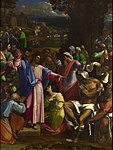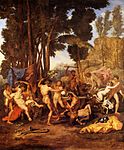
Thomas Gainsborough was an English portrait and landscape painter, draughtsman, and printmaker. Along with his rival Sir Joshua Reynolds, he is considered one of the most important British artists of the second half of the 18th century. He painted quickly, and the works of his maturity are characterised by a light palette and easy strokes. Despite being a prolific portrait painter, Gainsborough gained greater satisfaction from his landscapes. He is credited as the originator of the 18th-century British landscape school. Gainsborough was a founding member of the Royal Academy.

The National Gallery is an art museum in Trafalgar Square in the City of Westminster, in Central London, England. Founded in 1824, in Trafalgar Square since 1838, it houses a collection of over 2,300 paintings dating from the mid-13th century to 1900. The current Director of the National Gallery is Gabriele Finaldi.

Sir David Wilkie was a Scottish painter, especially known for his genre scenes. He painted successfully in a wide variety of genres, including historical scenes, portraits, including formal royal ones, and scenes from his travels to Europe and the Middle East. His main base was in London, but he died and was buried at sea, off Gibraltar, returning from his first trip to the Middle East. He was sometimes known as the "people's painter".

John Julius Angerstein was a London businessman and Lloyd's underwriter, a patron of the fine arts and a collector. It was the prospect that his collection of paintings was about to be sold by his estate in 1824 that suddenly galvanised the King, George IV, and the prime minister, Lord Liverpool, into purchasing his collection for the nation and led to the founding of the British National Gallery in Angerstein's house at 100 Pall Mall.

George Vincent was an English landscape painter who produced watercolours, etchings and oil paintings. He is considered by art historians to be one of the most talented of the Norwich School of painters, a group of artists connected by location and personal and professional relationships, who were mainly inspired by the Norfolk countryside. Vincent's work was founded on the Dutch school of landscape painting as well as the style of John Crome, also of the Norwich School. The school's reputation outside East Anglia in the 1820s was based largely upon the works of Vincent and his friend James Stark.
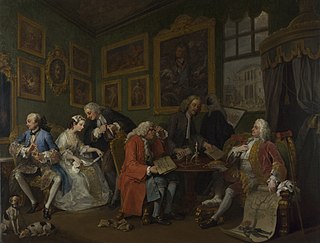
Marriage A-la-Mode is a series of six pictures painted by William Hogarth between 1743 and 1745, intended as a pointed skewering of 18th-century society. They show the disastrous results of an ill-considered marriage for money or social status, and satirize patronage and aesthetics. The pictures are held in the National Gallery in London.

William Leighton Leitch was a master Scottish landscape watercolour painter and illustrator. He was Drawing Master to Queen Victoria for 22 years. He was Vice President of the Royal Institute of Painters in Watercolours, on Pall Mall in London, for twenty years.

Sir George Howland Beaumont, 7th Baronet was a British art patron and amateur painter. He played a crucial part in the creation of London's National Gallery by making the first bequest of paintings to that institution.
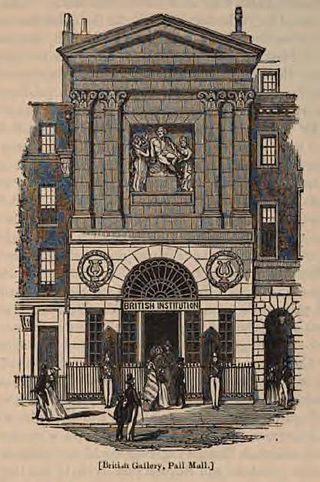
The British Institution was a private 19th-century society in London formed to exhibit the works of living and dead artists; it was also known as the Pall Mall Picture Galleries or the British Gallery. Unlike the Royal Academy it admitted only connoisseurs, dominated by the nobility, rather than practising artists to its membership, which along with its conservative taste led to tensions with the British artists it was intended to encourage and support. In its gallery in Pall Mall the Institution held the world's first regular temporary exhibitions of Old Master paintings, which alternated with sale exhibitions of the work of living artists; both quickly established themselves as popular parts of the London social and artistic calendar. From 1807 prizes were given to artists and surplus funds were used to buy paintings for the nation. Although it continued to attract members and visitors, in 1867, when the lease on its quarters expired, instead of renewing the society wrapped up its affairs.
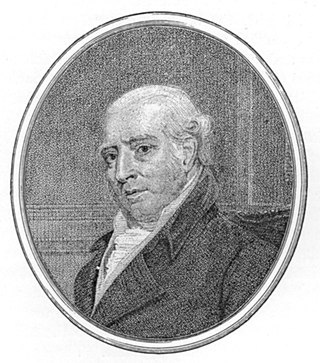
George Nicol was a bookseller and publisher in 18th-century London. In 1781, he became bookseller to George III, a position he held until 1820. In 1785, he published an improved edition of James Cook's third voyage. In 1786, he became involved with John Boydell's Shakespeare Gallery and bore responsibility for the letterpress. He and the others in the project wanted to create a type that would be both utilitarian and beautiful.

Robert Bowyer was a British miniature painter and publisher.
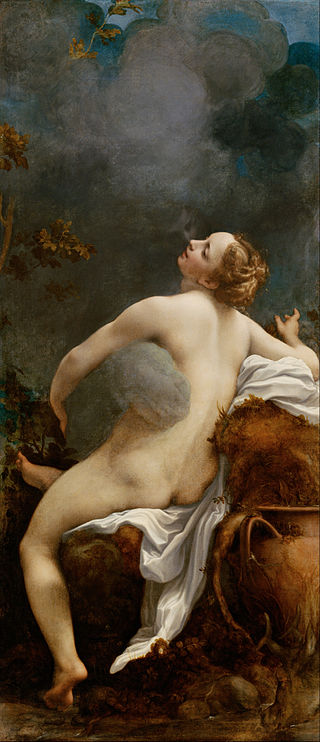
The Orleans Collection was a very important collection of over 500 paintings formed by Philippe d'Orléans, Duke of Orléans, mostly acquired between about 1700 and his death in 1723. Apart from the great royal-become-national collections of Europe it is arguably the greatest private collection of Western art, especially Italian, ever assembled, and probably the most famous, helped by the fact that most of the collection has been accessible to the public since it was formed, whether in Paris, or subsequently in London, Edinburgh and elsewhere.

The Boydell Shakespeare Gallery in London, England, was the first stage of a three-part project initiated in November 1786 by engraver and publisher John Boydell in an effort to foster a school of British history painting. In addition to the establishment of the gallery, Boydell planned to produce an illustrated edition of William Shakespeare's plays and a folio of prints based upon a series of paintings by different contemporary painters. During the 1790s the London gallery that showed the original paintings emerged as the project's most popular element.

Portrait of Pope Julius II is an oil painting of 1511–1512 by the Italian High Renaissance painter Raphael. The portrait of Pope Julius II was unusual for its time and would carry a long influence on papal portraiture. From early in its life, it was specially hung at the pillars of the church of Santa Maria del Popolo, on the main route from the north into Rome, on feast and high holy days. Giorgio Vasari, writing long after Julius' death, said that "it was so lifelike and true it frightened everyone who saw it, as if it were the living man himself".

The Reverend William Holwell Carr, (1758–1830) was an English priest, art dealer, art collector and painter. His bequest of paintings was an important early addition to the collection of the National Gallery in London.
John Absolon was a British watercolourist, specialising in figure painting. He studied in London and then Paris.

Alexander Day was a miniature painter and art dealer. Born in Britain, he worked chiefly in Rome.
Colnaghi is an art dealership in St James's, central London, England, which is the oldest commercial art gallery in the world, having been established in 1760.
George Kinnaird, 7th Lord Kinnaird (1754–1805) was a Scottish aristocrat, virtuoso, and banker. He was a representative peer in 1787.
